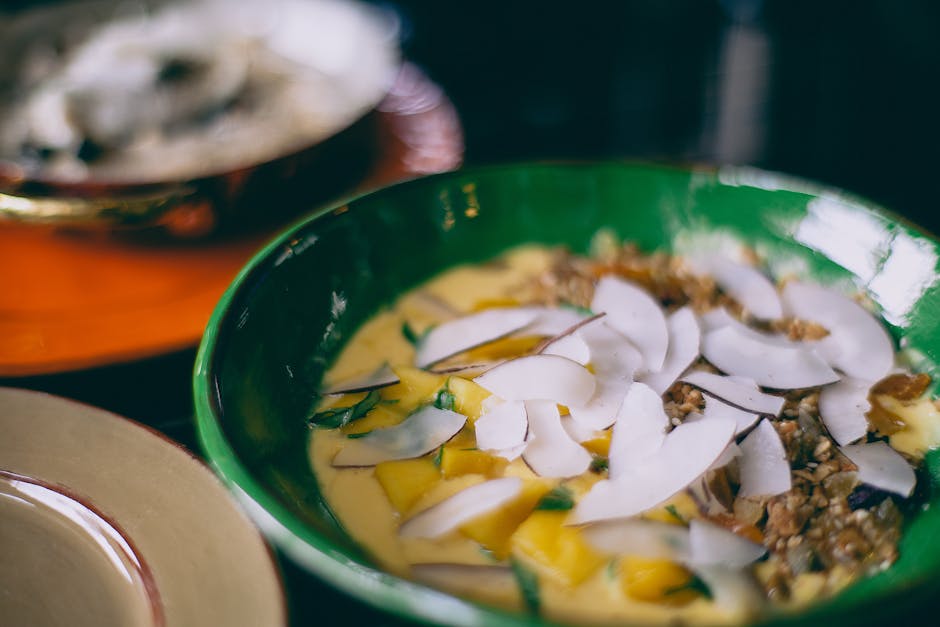The vibrant green hue and subtly sweet flavor of our Coconut Matcha Smoothie represent a delightful fusion of Eastern and Western culinary traditions. While pinpointing the exact origin of this specific combination is difficult, its constituent parts boast rich histories. Matcha, a finely ground powder of specially grown and processed green tea leaves, hails from Japan, where its cultivation and ceremonial use date back centuries. Zen Buddhist monks in the 12th century are credited with popularizing matcha for its purported ability to enhance focus and mindfulness. Its unique preparation method, ensuring the consumption of the entire leaf, delivers a concentrated dose of antioxidants and nutrients, far exceeding those found in steeped green tea. Studies have shown that matcha contains significantly higher levels of epigallocatechin gallate (EGCG), a potent antioxidant, than other teas.
The coconut, on the other hand, boasts a global history, with evidence suggesting its cultivation began thousands of years ago in Southeast Asia. Coconuts are incredibly versatile; their flesh, water, milk, and oil are all used in a vast array of cuisines and products worldwide. From tropical islands to bustling city streets, the coconut’s presence is a testament to its adaptability and nutritional value. Its creamy texture and subtle sweetness complement the slightly bitter notes of matcha perfectly, creating a balanced and harmonious flavor profile. This combination isn’t merely a trendy beverage; it represents a confluence of cultures and ingredients, highlighting the global reach of both matcha and the coconut.
The Coconut Matcha Smoothie’s rising popularity reflects a broader trend towards health-conscious consumption and interest in exotic flavors. The global smoothie market is booming, with projections showing continued growth in the coming years. Consumers are increasingly seeking out beverages that are both delicious and nutritious, and the Coconut Matcha Smoothie fits this demand perfectly. Its vibrant color and Instagram-worthy aesthetic further contribute to its appeal, making it a popular choice for health-conscious individuals and social media enthusiasts alike. Beyond its taste and visual appeal, this smoothie offers a convenient way to incorporate beneficial nutrients into one’s diet, providing a boost of energy and antioxidants throughout the day. The combination of matcha’s caffeine and the coconut’s healthy fats creates a sustained energy release, unlike the sugar crash often associated with other sugary drinks.
Ingredients and Measurements
This recipe yields one generous serving of Coconut Matcha Smoothie. Adjust quantities proportionally for larger batches. The success of this smoothie hinges on the quality of your ingredients, so we encourage you to use the freshest and highest-quality products available.
Matcha Powder: 1-2 teaspoons. This is where you can adjust the intensity of the matcha flavor to your preference. One teaspoon provides a subtle matcha taste, while two teaspoons deliver a bolder, more vibrant flavor. Using culinary-grade matcha is crucial for optimal taste and health benefits. Avoid using ceremonial-grade matcha, as it’s generally more expensive and its delicate flavor might be lost in the smoothie.
Coconut Milk (full-fat): 1 cup (240ml). Full-fat coconut milk provides the creamy texture and rich coconut flavor that forms the base of this smoothie. Avoid using light or low-fat coconut milk, as it will result in a thinner, less satisfying smoothie. If you only have light coconut milk, you can compensate by adding a tablespoon or two of full-fat yogurt or cream.
Frozen Mango Chunks: 1 cup (approximately 150g). Frozen mango is essential for achieving the desired smooth, icy consistency. Fresh mango can be used, but you’ll need to add a handful of ice cubes to compensate for the lack of frozen fruit. Using frozen mango also helps to naturally sweeten the smoothie, reducing the need for added sugar.
Pineapple Juice (unsweetened): ½ cup (120ml). Pineapple juice adds a delightful tropical twist and complements the coconut and matcha flavors beautifully. Using unsweetened pineapple juice is recommended to control the sweetness level. If you prefer a sweeter smoothie, you can add a touch of honey or maple syrup to taste, but start with small increments to avoid over-sweetening.
Coconut Water (optional): ¼ cup (60ml). Adding coconut water enhances the tropical flavor profile and provides added hydration. This is entirely optional, and you can omit it if you prefer a thicker smoothie. If you choose to include it, ensure you use 100% pure coconut water without added sugar.
Ice Cubes (optional): 2-3 cubes. Ice cubes are only necessary if you are not using fully frozen ingredients or if you prefer a thicker, icier smoothie. Start with fewer ice cubes and add more as needed to achieve your desired consistency. Over-icing can make the smoothie too thick and difficult to blend.
Other Optional Additions: Feel free to experiment with other ingredients to personalize your Coconut Matcha Smoothie. A pinch of ginger can add a warming spice, a squeeze of lime juice offers a zesty contrast, and a tablespoon of chia seeds provides added nutrition and thickness. Remember to adjust the liquid content accordingly if adding additional ingredients.
Important Note: Always measure your ingredients accurately for optimal results. Using a kitchen scale for weighing ingredients, especially the matcha powder and frozen fruits, can ensure consistency across batches.
Equipment List: Coconut Matcha Smoothie
Creating the perfect Coconut Matcha Smoothie requires the right tools. While you might be able to improvise with some items, having the proper equipment ensures a smooth, consistent, and delicious result every time. This list details the necessary equipment, along with recommendations for optimal performance and suggestions for alternatives where applicable.
Blender: This is arguably the most crucial piece of equipment. You’ll need a high-powered blender capable of pulverizing ice and blending the coconut flesh smoothly without leaving any chunks. A low-powered blender may struggle with the ice and coconut, resulting in a grainy texture. We recommend a blender with at least 1000 watts of power and a robust motor. Look for features like multiple speed settings and a tamper to push ingredients down the sides during blending. Brands like Vitamix and Blendtec are known for their superior performance, but many other high-quality blenders on the market will suffice.
Measuring Cups and Spoons: Accurate measurements are key to achieving the ideal flavor balance in your smoothie. Using standard measuring cups and spoons (1 cup, ½ cup, ¼ cup, 1 tablespoon, 1 teaspoon) will ensure consistency in your results. Invest in a good quality set to ensure accuracy. Avoid using casual kitchen utensils for accurate measurements.
Cutting Board and Knife: If you’re using fresh coconut, you’ll need a sharp knife and a sturdy cutting board to safely crack open the coconut and extract the flesh. A good quality chef’s knife (around 8 inches) is recommended for ease of use and safety. Ensure your cutting board is stable and large enough to accommodate the coconut. If using pre-shredded coconut, this step is unnecessary.
Vegetable Peeler (Optional): While not strictly necessary if using pre-shredded coconut, a vegetable peeler can be helpful for removing the tough brown outer layer from fresh coconut flesh before blending. This will make for a smoother, more refined texture in your smoothie.
Strainer or Fine-Mesh Sieve (Optional): If you prefer an extra-smooth smoothie without any coconut fiber, you can strain the blended mixture through a fine-mesh sieve or strainer after blending. This step is entirely optional, but it will result in a silkier texture. Choose a strainer with fine mesh to effectively remove any unwanted fibers.
Serving Glasses or Cups: Finally, you’ll need glasses or cups to serve your delicious Coconut Matcha Smoothie. Choose your favorite style – tall glasses are ideal for showcasing the layers and vibrant color of the drink. Consider glasses with a wide base for stability.
Additional Helpful Tools (Optional): A small bowl for prepping ingredients, a spatula for scraping down the blender sides, and a kitchen scale (for precise measurements of powdered ingredients) can further enhance the smoothie-making process. These are not essential but can significantly improve convenience and accuracy.
Preparation Phase: Washing and Chopping
Before we dive into blending our vibrant Coconut Matcha Smoothie, meticulous preparation is key to achieving a smooth, delicious, and visually appealing result. This section focuses on the crucial washing and chopping steps, ensuring both hygiene and optimal texture in our final product.
Let’s start with the fresh coconut flesh. We’ll need approximately 1 cup of shredded coconut for this recipe. If you’re starting with a whole coconut, you’ll first need to crack it open. This can be done by hitting it firmly with a hammer (wrapped in a towel for safety) or using a coconut cracker. Once cracked, drain out the coconut water – you can save this for another recipe or drink it fresh! Then, use a sharp knife to carefully remove the white flesh from the shell. Avoid cutting yourself – always use a sharp, well-maintained knife and a stable cutting surface.
Once the coconut flesh is free from the shell, grate it using a box grater or food processor fitted with a grating blade. Aim for a relatively fine shred for optimal blending and to avoid chunky bits in your smoothie. If using pre-shredded coconut, ensure it’s fresh and high quality. Look for options with minimal added sugars or preservatives.
Next, we’ll prepare the matcha powder. While this doesn’t require washing or chopping, it’s crucial to ensure the matcha is of good quality. The quality of your matcha significantly impacts the flavor and overall experience of the smoothie. Look for ceremonial-grade matcha for the best taste. Measure out 2 teaspoons of matcha powder using a measuring spoon. Avoid using a scoop from the container, as this can lead to inconsistent measurements and potentially introduce clumps into your smoothie.
Now, let’s address the optional ingredients. If you’re adding fresh spinach, you’ll need approximately 1 cup of packed leaves. Wash the spinach thoroughly under cold running water. Remove any wilted or damaged leaves. Give the spinach a good shake to remove excess water. Roughly chop the spinach into smaller pieces to facilitate easier blending. Smaller pieces ensure a smoother final product and prevent large chunks from getting stuck in your blender.
Similarly, if you’re incorporating frozen mango chunks – a fantastic addition for sweetness and creaminess – use about 1 cup. Ensure they are frozen solid for a thicker, colder smoothie. No washing or chopping is needed for frozen mango, but ensure they are not overly defrosted before adding them to the blender.
Finally, thoroughly wash all your utensils and prepare your blender before moving on to the blending phase. Cleanliness during preparation is paramount to creating a healthy and delicious smoothie.
Blending Instructions
Crafting the perfect Coconut Matcha Smoothie requires attention to detail and the right blending technique. Follow these instructions carefully to achieve a smooth, creamy, and vibrantly green beverage.
Preparation is key: Before you begin, ensure all your ingredients are chilled. Cold ingredients will result in a colder, thicker, and more refreshing smoothie. This is especially important for the coconut milk, as it can become quite thin if left at room temperature.
Ingredient Measurement: For a single serving, you will need the following ingredients: 1 frozen banana (sliced for easier blending), 1 cup of chilled coconut milk (full-fat recommended for creaminess), 1 teaspoon of high-quality matcha powder, ½ cup of ice cubes (adjust to your desired thickness), and 1 tablespoon of honey or maple syrup (optional, adjust to your sweetness preference). For larger batches, simply multiply these measurements proportionally.
Blending Process: Begin by adding the frozen banana slices, coconut milk, and ice cubes to your blender. It’s crucial to add the liquids first, followed by the frozen ingredients. This helps to lubricate the blades and prevent sticking. If your blender has a tamper, use it to gently push down ingredients towards the blades as you blend.
Matcha Incorporation: Next, add the matcha powder. Do not add it directly to the blender without the other ingredients. Adding it directly can result in clumping and an uneven distribution of matcha throughout the smoothie. Start blending on a low speed for a few seconds to incorporate the matcha powder evenly, gradually increasing the speed to high as the powder disperses.
Sweetener Addition (Optional): Once the matcha is fully incorporated and the mixture is smooth, add your chosen sweetener (honey or maple syrup). Taste the smoothie before adding all the sweetener, as the sweetness of the banana and coconut milk can vary. Blend for another 10-15 seconds to ensure the sweetener is completely dissolved.
Achieving Optimal Consistency: If your smoothie is too thick, add a splash more coconut milk, a tablespoon of water, or a few ice cubes. If it’s too thin, add a few more ice cubes. Blend for a few more seconds to adjust the consistency to your preference. A well-blended smoothie will have a smooth, creamy texture without any ice chunks.
Professional Tip: For the smoothest texture, use a high-powered blender. While you can use a standard blender, a high-powered blender will ensure there are no lingering ice chunks or matcha clumps. Also, consider using ripe, but still firm bananas for the best texture and sweetness.
Serving Suggestions: Pour your Coconut Matcha Smoothie into a chilled glass. Garnish with a sprinkle of extra matcha powder, a few coconut flakes, or a sprig of mint for an elegant presentation. Enjoy immediately for the best flavor and texture.
Serving Suggestions
Your vibrant and delicious Coconut Matcha Smoothie is ready to be enjoyed! To maximize its flavor and texture, consider these serving suggestions. We’ve crafted options for various preferences and occasions, ensuring you get the most out of each delightful sip.
For the Classic Enjoyment: Simply pour your smoothie directly into a chilled glass. We recommend using a tall glass (approximately 16 ounces) to showcase the beautiful layering of the smoothie if you’ve made it with layered ingredients. For optimal temperature, enjoy it immediately after blending for the freshest, most vibrant flavor. A straw is optional but recommended for easy sipping.
Elevating the Experience: To enhance the presentation and sensory experience, consider adding a few garnishes. A sprinkle of matcha powder on top creates a visually appealing dusting and adds a subtle extra matcha flavor. A few thin slices of fresh lime or a wedge of lime on the rim provide a refreshing citrusy contrast to the creamy coconut. A small sprig of mint adds a touch of elegance and a hint of refreshing coolness. Remember to keep garnishes minimal to avoid overwhelming the delicate matcha flavor.
Serving Size and Quantities: This recipe yields approximately two 16-ounce servings. Adjust the ingredient quantities proportionally if you need to make more or less. For example, if you’re making a larger batch for a gathering, simply double or triple the recipe. Ensure you use a high-powered blender to adequately process the larger quantity.
Pairing with Foods: Your Coconut Matcha Smoothie pairs beautifully with a variety of light breakfast or snack options. Consider serving it alongside a small bowl of fresh berries (approximately ½ cup), a piece of whole-grain toast (one slice), or a small portion of granola (about ¼ cup). These additions provide a balance of flavors and textures, complementing the smoothie’s creamy texture and subtle earthy notes. Avoid pairing with overly sweet or heavy foods, as this might overpower the delicate matcha taste.
Temperature Variations: While best served chilled, you can also enjoy this smoothie slightly warmed. Gently heat it in a saucepan over low heat, stirring frequently to prevent scorching. Do not boil the smoothie, as this will destroy the beneficial nutrients and alter the texture and taste. A warm version might be particularly comforting on a chilly day. Consider adding a dash of cinnamon or nutmeg for an extra warming spice note.
Storage and Reheating: Leftover smoothie should be stored in an airtight container in the refrigerator for up to 24 hours. However, we strongly recommend consuming it within 12 hours for optimal freshness and flavor. If reheating, do so gently as described above. Avoid repeated freezing and thawing, as this can negatively impact the texture and taste.
Creative Variations: Feel free to experiment with adding other ingredients to personalize your smoothie. A tablespoon of chia seeds or flax seeds adds a boost of fiber and healthy fats. A small amount of honey or maple syrup (1-2 teaspoons) can be added for extra sweetness, if desired. However, remember to adjust to your taste preferences. Always taste and adjust sweetness before serving.
Tips and Tricks for a Perfect Coconut Matcha Smoothie
Creating the perfect Coconut Matcha Smoothie involves more than just throwing ingredients into a blender. Follow these tips and tricks to achieve a consistently delicious and visually appealing drink every time.
Start with the right ingredients: The foundation of a great smoothie lies in the quality of its components. Use ripe, high-quality bananas for natural sweetness and creaminess. Opt for good quality matcha powder – ceremonial grade is ideal for its richer flavor and vibrant green color. Use full-fat coconut milk for a decadent texture and creamy mouthfeel; light coconut milk will result in a thinner smoothie. Measure your ingredients carefully for consistent results. A good starting point is 1 frozen banana, 1 cup of full-fat coconut milk, 1 teaspoon of matcha powder, and ½ cup of ice.
Mastering the Matcha: Matcha can be tricky. Avoid clumping by sifting the powder before adding it to the blender. This ensures even distribution and prevents gritty textures. If you’re using a sweeter matcha, you may need to adjust the amount of banana or other sweetener you use. Start with a smaller amount and taste-test before adding more. A good tip is to combine the matcha powder with a small amount of liquid (coconut milk works well) to form a paste before adding the rest of the ingredients. This prevents clumping and ensures a smooth, well-incorporated flavor.
Ice is key: The amount of ice directly impacts the smoothie’s consistency. For a thicker smoothie, use more ice (up to 1 cup). For a thinner smoothie, use less. Using frozen ingredients like bananas and mango chunks will also contribute to a thicker, colder smoothie and reduce the need for excessive ice. Experiment with different ice types; crushed ice blends more easily than cubes but may result in a slightly less smooth texture.
Liquid Balance: The liquid content determines the smoothie’s thickness. Start with the recommended amount of coconut milk and adjust according to your preference. If your smoothie is too thick, add more coconut milk, a splash of water, or even a little almond milk. Too thin? Add more frozen fruit or ice. Remember that the consistency will change as the smoothie sits, so adjust the liquid accordingly.
Sweetness Level: Ripe bananas provide natural sweetness. However, you can adjust the sweetness to your liking. If you prefer a sweeter smoothie, add a touch of honey, maple syrup, or agave nectar. Start with a small amount and add more as needed. Always taste test before making significant adjustments. Consider adding a pinch of salt to enhance the sweetness and balance the flavors.
Blend to Perfection: Blend on high speed for at least 30-60 seconds, scraping down the sides of the blender as needed to ensure all ingredients are thoroughly combined. A high-speed blender will yield a smoother, creamier result. If using a less powerful blender, you may need to blend in stages, starting with the liquids and then gradually adding the solids.
Garnish and Serve: Once blended, pour your Coconut Matcha Smoothie into a glass. Garnish with a sprinkle of extra matcha powder, a few coconut flakes, or a fresh mint sprig for an elegant touch. Serve immediately for the best taste and texture.
Recommendations for Coconut Matcha Smoothie
Our Coconut Matcha Smoothie is a delightful blend of creamy coconut, earthy matcha, and subtly sweet natural flavors. To ensure you get the most out of this refreshing beverage, we offer the following recommendations:
Serving Suggestions: For the ultimate experience, we recommend enjoying your Coconut Matcha Smoothie immediately after preparation. This ensures the optimal texture and flavor profile. However, if preparing ahead, see storage recommendations below. Consider adding a few ice cubes for an extra-chilled treat, or garnishing with a sprinkle of matcha powder, shredded coconut flakes, or a few fresh berries for an attractive and flavorful finish. A sprig of mint adds a refreshing touch. Experiment with different toppings to find your perfect combination! You can also adjust the sweetness by adding a touch more honey or maple syrup (adjust to taste).
Storage Conditions: While best enjoyed fresh, leftover Coconut Matcha Smoothie can be stored in an airtight container in the refrigerator for up to 24 hours. However, we strongly advise against freezing the smoothie, as this can affect the texture and potentially separate the ingredients. The smoothie may also become watery or icy upon thawing. If storing, ensure the container is properly sealed to prevent any flavor loss or absorption of other odors from the refrigerator.
Complementary Dishes: This smoothie pairs beautifully with a variety of breakfast and brunch options. Consider it alongside a light and fluffy stack of whole-wheat pancakes or a bowl of fresh fruit salad for a balanced and nutritious meal. It also complements lighter lunch options such as a quinoa salad or avocado toast. The earthy matcha flavor complements the savory notes of these dishes without overpowering them. For a more decadent pairing, enjoy it with a small piece of coconut cake or a light pastry.
Nutritional Information (Approximate per serving, 8oz): These values are estimates and may vary slightly depending on the specific ingredients used.
- Calories: Approximately 250-300 calories
- Fat: 15-20g (mostly healthy fats from coconut)
- Carbohydrates: 25-35g
- Protein: 5-10g (depending on added protein sources)
- Fiber: 3-5g
Note: This nutritional information does not include any added sweeteners or toppings. The calorie and macronutrient counts will increase if you add additional ingredients.
Important Considerations: Individuals with sensitivities to coconut or matcha should exercise caution and consult with a healthcare professional before consuming this smoothie. Adjust the recipe according to your dietary needs and preferences. Always use fresh, high-quality ingredients for the best taste and nutritional value. Enjoy responsibly!





